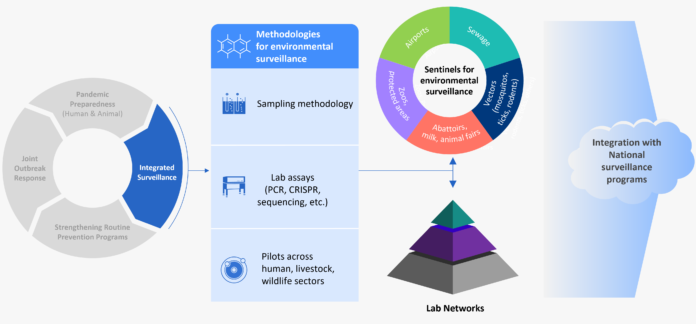ONE HEALTH PERSPECTIVE FROM INDIA’S POINT OF VIEWS : ANIMAL HEALTH FOR HUMAN HEALTH
The one health concept recognizes that the health of humans, domestic and wild animals, plants, and the wider environment (including ecosystems) are closely linked and interdependent. The approach emphasizes the need for collaboration between different disciplines, including veterinary medicine, human medicine, and environmental science, to address complex health issues that impact multiple species. In India, where the majority of the population relies on agriculture and livestock farming, the One Health approach is of utmost importance.
One Health (OH) is a collaborative, multisectoral, coordinated, and transdisciplinary approach – working at the local, regional, national, and global levels – with the goal of achieving optimal health outcomes by recognizing the interconnection between people, animals, plants, and their shared environment. With the increase in population, industrialization, and geopolitical problems, global changes are accelerating which damage the biodiversity, ecosystems, and migratory movements of both humankind and species in general. Rapid climate and environmental changes have led to the emergence and reemergence of infectious and noninfectious diseases .
Since time immemorial, human civilization has been closely associated with animals, plants, and the environment. We are dependent on different components of nature for our livelihood. It is essential to maintain an equilibrium amongst the different components to have a better life for mankind on this planet. Animals are an integral part of our life in many ways. We, besides being dependent for food, also rely upon animals for our sound health. Animal diseases have considerable importance in human welfare both as a cause of illness in man as well as reducing the food potential of the world. Here, comes a previously less discussed topic called zoonosis or zoonotic disease. The intricate web of life on Earth interconnects the health of animals, humans, and the environment. Recognizing this interdependence, the One Health approach emphasizes the inextricable link between animal and human health. In this article, we delve into the profound implications of One Health, emphasizing how the well-being of animals contributes directly to the health of humans and the broader ecosystem.
What is a Zoonosis?
As defined by the WHO expert committee on zoonosis, it is “any disease or infection that spreads between vertebrate animals and human being”. The term “zoonosis” was first coined by Rudolph Virchow. In simple words, its transmission is a two-way process which means infections may spread from animal to human or vice-versa. We are usually more concerned about the diseases that spread from animals to human. However, there are several diseases that spread from animal to human and the list is endless. Rabies, bird flu, Salmonellosis, Tuberculosis, Anthrax, Tapeworm, Ebola, Nipah, Hendra etc. are some such examples.
Zoonotic diseases are caused by infectious microorganisms like virus, bacteria, parasites and protozoa. These organisms are generally spread frequently in close association. Following are some means of their transmission.
- Close contact with animals ensures rapid spread of the infections from animals to susceptible human.
- Some of the causative agents of such diseases are excreted in all secretions like urine, faeces, saliva, breathe, etc. which contaminate the surrounding microclimate. We are exposed to such infection through contaminated air, water, food, utensils, packaging materials, etc. Excretion of Rabies virus in saliva, Leptospirain urine, gut bacteria and protozoal pathogen in faeces, Salmonella and coli in water are some examples.
- Some of the microorganisms are spread while handling and consumption of meat, milk and other raw animal products. Bacterial pathogen Salmonella, Shigella, coli, Listeria are included in this list.
- They may also be spread by fomites, vectors like mosquito, fly, tick, flea, lice etc. Bites, scratches, and licking by animals are also potential sources of spreading zoonotic diseases. Vector-borne diseases like Japanese encephalitis, Dengue etc. are causing serious impact on human health every year.
- Traditional feeding and other practices that are prevalent in tribal areas of particular location may be another cause of spillover of zoonotic infections. For example, eating raw or undercooked/smoked pork predisposes to Taeniasis.
A wide group of people like animal handlers, owners, farm workers, veterinarians, animal attendants and supporting staff at veterinary hospitals, animal activists, farmers, animal rescuers and butchers are regularly associated closely with the animals because of their professional affairs. Besides, we are indirectly in contact with the animals through handling and consumption of products like milk, meat and eggs.
Impact on human health:
Several literature and data suggest a strong link between human and animal health. Amongst all infectious diseases of human being, nearly 60 percent are transmitted from animals. According to Center for Disease Control (CDC), USA, 3 out 5 emerging diseases of human are caused by infections transmitted from animals. These diseases are causing severe threat to the humanity in terms of mortality and morbidity from time to time. A few of their impacts are highlighted below.
- We are more or less aware about rabies, an old fatal zoonotic disease of all domestic animals and human. It is transmitted by bites of animals specially carnivores which act as a carrier of the virus. As per available literature, rabies kills around 18000-20000 lives every year which is 36 percent of world’s total mortality.
- Bioterrorism is not a new concept for us. Many a times, newspaper headlines are captured by news of conspiracy to kill various important persons of various countries around the world. The causative organism of Anthrax, Bacillus anthracisis mostly used in bioterrorism, which is very deadly and the origin of infection is herbivore animals.
- In parts of India, every year with the onset of monsoon, it is a routine to have news on mortality due to vector-borne diseases like Malaria, Japanese Encephalitis etc. These diseases are transmitted by infected mosquito bites. Especially for Japanese Encephalitis virus, pigs act as a reservoir host, thus harboring the infection without any overt clinical signs. Pig farmers, who are in close proximity in an unhygienic situation that favours multiplication of mosquitoes, are highly susceptible and pick up the infection from mosquito bites.
- The recent havoc of COVID19 pandemic is known to all of us and this taught a lesson to the mankind. The whole world underwent a total lockdown to curb the infection. Even though the source of the virus is unknown, some reports speculated its link with a sea food market in Wuhan.
- Many a times we are shaken by many pandemics like Ebola, Nipah, Hendra etc. Similarly, avian influenza or bird flu is also very well known to us. It is a deadly pathogenic infection transmitted to human from poultry.
- Very recently, there was a report of outbreak of monkey pox in India.
The above-mentioned are only few examples of the vast ocean of zoonotic diseases. Emerging and remerging zoonotic diseases are taking the lead causing a huge suffering to us. These infections are challenging the human race from time to time in terms of morbidity, mortality as well as socio-cultural and economic aspect.
Prevention strategies for zoonoses:
“Prevention is better than cure” principle is best applied in the animal practice because of several reasons. Costs incurred in the treatment, production loss during suffering and fast spread because of close contact etc. make treatment an unfavorable option specially in large flock of animals. Following measures may be adopted to control the spread of zoonoses.
- Vaccination is by far the most effective preventive measure for several deadly zoonoses like Rabies. For example, Rabies is well prevented through adoption of vaccination practice in animals. Regular vaccination of pets as well as street dogs is an effective measure to control Rabies.
- Strict compliance of biosecurity measures in an affected area. This practice checks the unwanted movement of people andvehicles into the affected areas so that the infection can be contained in a limited area.
- Drinking water is a potential source of acquiring various diseases especially those that are responsible for gut pathology in human being. Clean, disinfected drinking water can resolve this issue.
- People who are professionally compelled to be in touch with sick animals should take an utmost precaution in handling the animals. Avoidance of touching with bare hands, use of mask, and use of protective cloth is highly essential for such persons.
- For control of insect-borne diseases, clean and surrounding atmosphere is highly essential. Use of mosquito nets, defogging practice, repellents etc. will reduce the insect burden and diseases thereof.
- Proper disposal of animal droppings and urine will reduce the burden of various diseases like Leptospirosis, Protozoal infections etc.
- Animal carcasses should be disposed off properly. In many instances, carcasses are thrown into some open areas which can act as a bomb to spread and contaminate the environment, people and other animals in large numbers. It is always advisable to bury such animal carcasses.
The list of control measures to be adapted will be endless. Many a times, we have separate preventive strategies for individual diseases. Above all, most important is to create awareness among the general public about the disease and its preventive measures. It is impossible to have a fruitful preventive measure without a community participation. For better curbing of such issue, a comprehensive approach covering all stakeholders.
One health approach
Development and implementation of a collective effort among health, animal and environmental sectors is simply regarded as the one-health concept. This concept helps to understand the interactions among health, animal and environment sectors and their linkage in respect of emergence of various infectious diseases. For better implementation of the same, interdisciplinary collaborative work plan between wildlife conservationist, veterinarian, ecologist, behavioral scientist, physicians, infectious disease specialist, epidemiologist etc. among other is a must. It will help to ensure better understanding of zoonoses as well as emerging infections of animals and human besides the nature.
National One Health Mission
There are many One Health efforts underway in various Ministries of the Government of India, in private organizations in addition to a range of activities globally. This presents a prospect to review the areas of focus underlying each effort, identify opportunities for collaboration and work towards filling any remaining gaps. Considering this, The Prime Minister’s Science, Technology, and Innovation Advisory Council (PM-STIAC) in its 21st meeting, approved to set up a National One Health Mission with a cross-ministerial effort which will serve to coordinate, support, and integrate all the existing One Health activities in the country and fill gaps where it is appropriate.
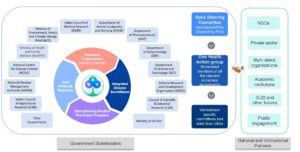
Key Stakeholders
Goals of the One Health Mission
The Mission aims to coordinate across achieving overall pandemic preparedness and integrated disease control against priority diseases of both human and animal sectors, with early warning systems built on integrated surveillance system and response readiness for endemic as well as emerging epidemic or pandemic threat.
The mission will also address critical pillars of preparedness in the form of targeted R&D to develop important tools such as vaccines, diagnostics and therapeutics, readiness in terms of clinical care, streamline data and information linkages and access across sectors as well as close community participation to keep our readiness to respond.
The following specific efforts will be undertaken in the National One Health Mission :
Implementing integrated disease surveillance within and across human, animal, and environmental sectors to address communicable diseases of zoonotic, transboundary animal diseases and diseases of epidemic/pandemic potential. This includes building early warning systems and integrating information coming from clinical and epidemiological data, information from various surveillance programs regardless of the agencies across sectors implementing it and deploying novel approaches such as environmental surveillance for timely and more accurate detection of diseases.
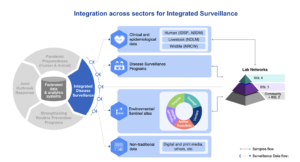
Integration across sectors for Integrated Surveillance
Environmental surveillance system- The One Health Mission envisions a robust network of sentinel-based surveillance that provides an ongoing real time picture of pathogens/disease spread that when linked to other sources of information, can be powerful adjunct to fill a major gap in our understanding of disease transmission dynamics across multiple diseases across human, animal husbandry and wildlife.
Sentinels include sewage, vectors (such as mosquitoes, ticks, rodents etc.), milk, places of aggregation such as animal trade and water holes, abattoir effluents and ports of entry such as airports. This system can also serve as the backbone, once established to bring the environmental components, including signs of habitat change, AMR surveillance, water quality etc.
A pictorial representation environmental surveillance, its methodologies and sentinels is depicted below.
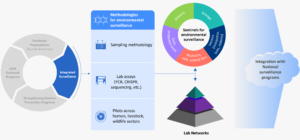
Environmental surveillance provides cost effective and sensitive approaches to detect diseases that are priority for elimination or eradication since as the disease prevalence goes down and program gets closer to elimination, traditional surveillance methodologies may not provide sufficient sensitivity. Introducing environmental surveillance can serve as a powerful and novel adjunct to the disease elimination programs. List of diseases that are on target for elimination and concerted efforts are to be undertaken to implement sentinel-based surveillance for these diseases.
Develop robust outbreak investigation mechanisms for effective investigation and control of diseases across human, animal husbandry and wildlife sectors with framework for joint investigations. This includes building outbreak response teams at national levels linked to respective state programs and strengthening district level outbreak response teams such as Rapid Response Teams (RRTs), with clear framework for functioning as a connected system for routine disease control programs for addressing both endemic and emerging diseases.
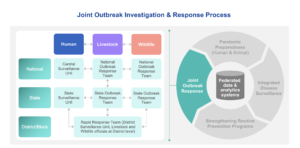
Joint Outbreak Investigation & Response Process
All the aspects of pandemic preparedness will be embedded in the routine prevention programs to ensure sustainability and continued improvement of both aspects.
Critical enabling activities of the One Health Mission
These outcomes of the One Health Mission will be supported by critical enabling initiatives. Many of these initiatives are ongoing and will be strengthened under the mission and several new activities that will facilitate the goals of the mission will be undertaken.
Critical enabling activities of the One Health Mission
Exercises to strengthen the existing programs and enable their integration in the One Health Mission
State pilots are being developed to better inform the implementation and to ensure that the Mission is grounded and informed by ongoing activities and capabilities. Moreover, following detailed mapping exercises are being conducted. This will ensure continuous strengthening of the existing programs and systems.
Disease gap prioritization exercise: A comprehensive collation of all the diseases of One Health priorities (zoonotic, transboundary animal diseases and diseases of epidemic/pandemic potential) and available interventions (vaccines, therapeutics, and diagnostics) across human, animal husbandry and wildlife sectors has been performed with extensive consultations. Gaps thus identified will be prioritized to serve as a guide for targeted R&D or epidemiological studies. This is envisioned to be a live database that will be continuously updated as the program evolves.
Mapping of existing surveillance programs: Before considering integrating disease surveillance, a comprehensive mapping of all ongoing disease surveillance programs (both active and passive surveillance) across the sectors has been undertaken. Overlaps and potential opportunities for integrating them further will be taken up.
Mapping of laboratory capabilities of existing and upcoming BSL-2, 3 and 4 levels for better understanding of country’s capabilities has been done. This critical lab infrastructure will be better integrated into a national network to achieve effective resource utilization and capacity building both for routine disease control and addressing emerging pandemics.
Mapping institutional capabilities: India has strong capabilities both within and outside government departments. A mapping exercise was undertaken to assess the core capabilities of institutions of the stakeholder departments and highlight where they can contribute towards the Mission. This will further provide a collective understanding of the roles to be played in building a One Health ecosystem.
The ability to predict, detect and respond to an infectious disease reflects fundamental capability of a system, and the efforts mentioned above are useful not just for natural origins of the infection but also accidental or intentional spreads. One Health concept is comprehensive and encompasses overall health of all living beings as well as that of the environment. This includes issues such as food security, water quality, antimicrobial resistance, and climate change. These are also being handled globally through quadripartite and G-20 forum. This mission aims to take up the specific issue of integrated disease control and pandemic preparedness within the broader landscape of One Health. Achieving meaningful progress in a focused manner will not only help in addressing this important topic and but also will provide valuable insights and lessons to further take up other issues of One Health.
Conclusion:
The One Health perspective is not merely a theoretical framework; it is a call to action for individuals and institutions worldwide. Recognizing the interconnectedness of animal, human, and environmental health is crucial for addressing emerging challenges, preventing pandemics, and promoting sustainable practices. By embracing the One Health approach, we pave the way for a healthier, more resilient future where the well-being of animals and humans harmoniously coexists within the broader ecosystem.
Zoonosis is an important yet neglected issue for us. Mass awareness of public will help in better understanding of such problems and will be helpful in successful implementation of the preventive strategies. WHO’s “one-health initiative” is a pathfinder step covering all stakeholders of human health, animal health and environmental health. This is a benchmarking initiative to have control over zoonoses and ensuring a sound world and healthy earth for all of us.
Compiled & Shared by- This paper is a compilation of groupwork provided by the
Team, LITD (Livestock Institute of Training & Development)
Image-Courtesy-Google
Reference-On Request


